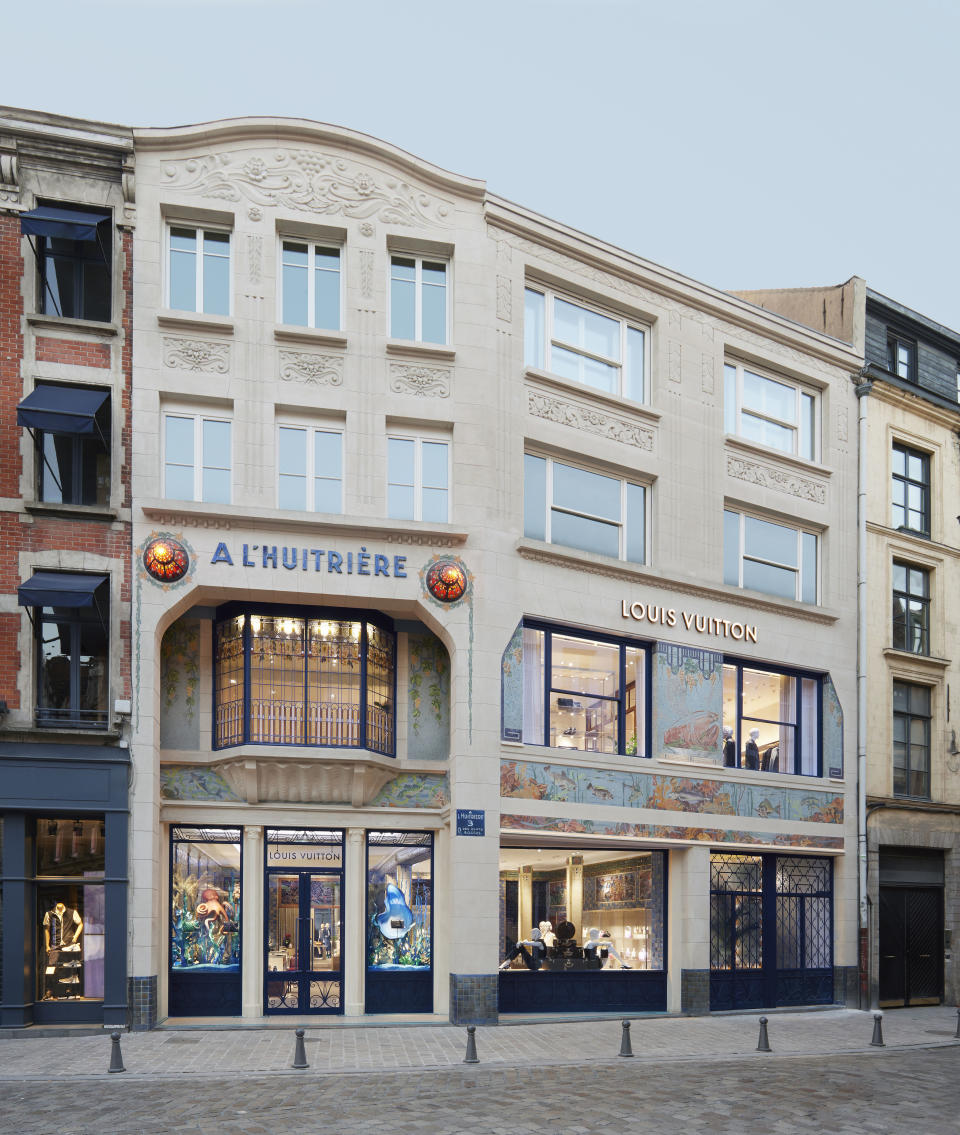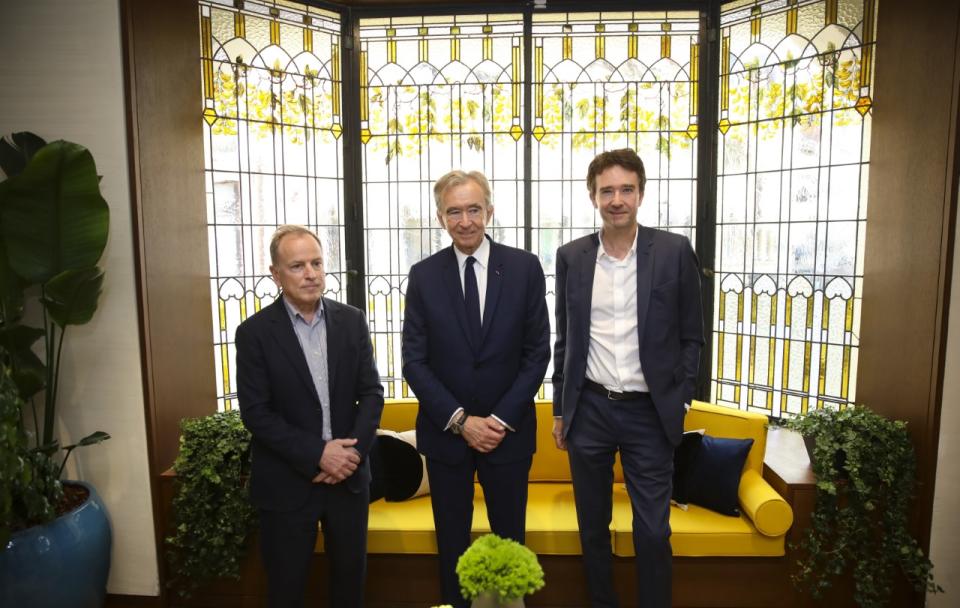Louis Vuitton’s New Boutique in Lille Was Once a Mecca for Oysters
- Oops!Something went wrong.Please try again later.

For high-flying Louis Vuitton, you might say the luxury world is its oyster — and now it has L’Huitrière, an Art Deco landmark in Lille, France, that has been associated with fine shellfish since 1928. (Huître is the French word for oyster.)
On Thursday, Bernard Arnault, chairman and chief executive officer of LVMH Moët Hennessy Louis Vuitton, and Michael Burke, chairman and CEO of Louis Vuitton, traveled to the city in northern France to christen a most unusual, colorful and atmospheric Vuitton boutique.
More from WWD
Home to a Michelin-star restaurant until 2015, L’Huitrière has been painstakingly renovated over the past year, preserving its listed facade and fully tiled interiors, reflecting a time when it also sold fresh shellfish and hosed down the walls and floor at the end of the day.
Vuitton called on a host of specialist craftspeople — in ironwork, marble, glass-paste marquetry, limestone, sandstone and brick — to convert the space into a two-level boutique that could accommodate a broader product assortment than the previous Lille location a stone’s throw away. Some 30 local companies were conscripted.
“It’s the epitome of made-to-order. Every square inch has been restored to its original state, down to the hinges,” Burke enthused in an interview on Thursday. “It makes the store unique, and at the end of the day, this is what people are looking for, unique experiences.”

STEPHANE MURATET
The executive estimates that about half of Vuitton’s stores in Europe are located in buildings designated as historic monuments, including in Paris, Munich, Hamburg, Vienna, Luxembourg, Florence, Rome, Brussels, Copenhagen, Oslo, Barcelona and Amsterdam. Last February, the brand also inaugurated a leather goods workshop housed in the historic Abbaye building in Vendôme, which dates back to the 11th century and variously housed a Benedictine monastery and a cavalry regiment.
While most companies shun listed buildings, Vuitton actively scouts them, prizing the locations for the unique architecture, history and ambiance, in spite of the challenges, intricacies and time demands of restoration. In Lille, for example, between 20 and 30 percent of the ceramic tiles needed to be reproduced in bespoke colors, and the refrigerators, storage cupboards and kitchen worktops were also preserved.
“It’s a lot more rewarding, interesting and long-term-looking than building a shopping center out in the boonies,” Burke said, also suggesting it’s more responsible to repurpose buildings instead of demolishing them.
He characterized the restoration of historic structures as a large-scale form of “recycling and upcycling” that ultimately has a positive impact on cities. L’Huitrière sat empty for years before Vuitton swooped in with a lease and a will to restore its former glory.
Located at 3 Rue des Chats-Bossus in what is considered Old Lille, L’Huitrière was designed by architect Gaston Trannoy and is considered a masterpiece of decorative arts from the period. The facade boasts a pediment carved with floral motifs and a cluster of grapes; a bay window buttressed by a stylized oyster shell, and mosaic panels depicting the undersea world. The original sign, even larger than the Louis Vuitton insignia, is flanked by two stained glass sea urchins.
The boutique unfurls like an apartment, with handbags arranged on bookshelves, and rooms appointed with vintage furniture, including a table by Guillerme and Chambron, two designers from the 1950s hailing from northern France.
There are two exceptional fireplaces by ceramist Emile Miller, who participated in the universal exhibitions where Vuitton, founded in 1854, gained renown as a trunkmaker and specialist in goods for travel. A small exhibition of trunks is a wink to this legacy.
Accessories, perfumes and travel items are displayed over two floors linked by a monumental staircase with a railing etched in Art Deco patterns. Dotted here and there are design objects known as Objets Nomades, including a lantern by Edward Barber and Jay Osgerby, a table by Atelier Biagetti, and vases by Tokujin Yoshioka.
When Vuitton’s retail team suggested using what was the restaurant’s cozy back room for stock, Burke insisted it remain part of the retail floor. Here women’s ready-to-wear is showcased.
Men’s ready-to-wear and shoes are among the new categories the L’Huitrière location can accommodate. At about 4,850 square feet, the new Lille store is more than three times bigger than the previous location. Vuitton said it doubled the size of the staff for the new boutique, which opens to the public on Friday.
Vuitton has a long history with Lille, as does its top executives.

Courtesy of LVMH
Arnault, who was born in nearby Roubaix, was a regular patron of the restaurant early in his business career. After attending the elite French military and engineering institute École Polytechnique in Paris, Arnault returned to his hometown to take over the family construction business.
Last July, Arnault was back in Lille to inaugurate a new vocational training program LVMH created with the business school EDHEC and named after the luxury titan’s father, Jean Arnault.
Burke attended EDHEC, and when he graduated, he invited his parents for dinner at L’Huitrière to thank them. “It bankrupted me,” he recalled with a chuckle. “It was THE restaurant” where a who’s-who of local business, political and cultural glitterati were escorted to the eatery’s back room, prized for its fireplace, privacy and proximity to the cathedral and canal it once abutted.
“It’s a bit of a homecoming for Bernard — and for me,” Burke said.
Vuitton has operated a boutique in Lille since 1909, one of the French firm’s early expansion vectors beyond Paris. A London store opened in 1885, Nice in 1908, and Cannes in 1924.
The larger Lille boutique signals its “loyalty to all regions of France,” according to the company, which added footwear to its Bordeaux location a few weeks ago, and plans to inaugurate an enlarged location in Lyon in September than can accommodate ready-to-wear and shoes. A temporary men’s boutique is slated to open in Cannes this summer, allowing its Boulevard de la Croisette permanent store to be entirely dedicated to women’s categories for five months.
The brand currently operates 10 stores in Paris and 12 in other French cities including Courchevel, Marseille, Monaco, Strasbourg, Toulouse and Deauville, the latter also housed in a listed building. Staffing in stores outside of Paris has increased by about 30 percent since 2019.
Burke explained that secondary French cities have been flourishing in recent years, with the pandemic further spurring a migration from the metropolis of Paris.
“These cities where the quality of life is much higher are really developing. Wealth is being created there and wealth is moving there,” he explained.
France accounted for about 6 percent of LVMH’s business in 2021, but it does not break down performance by brand.
“Our European business is very strong with Europeans,” Burke offered with a smile.
SEE ALSO:
LVMH Q1 Revenues Jump Despite War in Ukraine, China Lockdowns
LVMH Backs French Business School Campus for Entrepreneurs
Louis Vuitton Is Opening a Restaurant
Launch Gallery: Inside Louis Vuitton’s New Boutique in Lille
Sign up for WWD's Newsletter. For the latest news, follow us on Twitter, Facebook, and Instagram.

